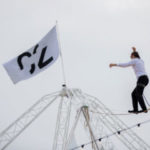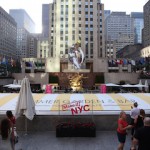
My dreams, for weeks after I returned home, spilled over with mental snapshots that I had taken during my whistle-stop tour of Ireland. The velvet-green patchwork of countryside where serene sheep and cows grazed alongside ancient, mystical stone towers, crumbling walls, and castle remains — making for a consistently awe-inspiring landscape along the modern motorways I traveled. The expertly prepared meals I was served. The historic and brand-new venues I was shown with obvious pride. The warm and friendly people I met. All of my encounters during my eight-day trip bubbled up in my subconscious.
Ireland casts its spell on every visitor. And while I admit to being among the legions who have succumbed to its charms, my dreams also were my brain’s way of unpacking the wealth of information and experiences I had acquired during a seven-city itinerary, jam-packed with visits to conference centers, universities, hotels, special-event venues, and cultural attractions. Taken together, they demonstrated how Ireland’s diverse cities and destinations are coming into their own as conference hosts possessing a wealth of knowledge and resources unique to their locale, as well as the infrastructure and amenities that provide international attendees with one-of-a-kind experiences.
Hosted by the Meet in Ireland team, I began my visit in mid-September in Northern Ireland, arriving at Belfast International Airport. I crisscrossed the island for more than a week, visiting Belfast, Derry-Londonderry, Dublin, Cork, Killarney, Adare, and Limerick, and departing from Shannon Airport. Each destination had its own distinct personality and story to tell — which is really what the Irish do best.
Day One: Belfast
After a six-and-a-half-hour direct flight from Newark Airport, I was met at Belfast International Airport by my driver for the week, Paudy McCaughey. As we stepped out of the terminal into the warm sunshine of a bright Irish morning — the first in a string of sunny, mild days with only a hint of fall — to begin our journey together, it became apparent that Paudy is a knowledgeable National Tour Guide of Ireland. And although I was counting down the minutes until my next coffee to fend off jetlag, I was pleasantly distracted by the vividly green fields outside my window and absorbed by Paudy’s insights about what we were seeing and what was to come. It’s a short, 18-mile motorway trip, and before I knew it, we’d pulled up to our first stop, the historic, 272-room Europa Hotel, in the heart of Belfast.
You’d never know that during “the Troubles” — the political conflict that defined Northern Ireland from the late 1960s until the signing of the Belfast Good Friday Agreement in 1998 — the four-star Europa was bombed 28 times. This grande dame has more than dusted herself off, hosting prestigious events and innumerable conferences — most recently, last month’s 500-delegate International Conference on Bioinformatics & Biomedicine — as well as VIPs and dignitaries. From my spacious suite, I gazed across the street to get my bearings in this bustling city, and the Crown Bar, a gem of a Victorian saloon owned by the National Trust, glinted up at me.
Downstairs, Visit Belfast’s Josephine Young and Howard Hastings, managing director of six luxurious hotels in Northern Ireland and outgoing chair of the Northern Ireland Tourist Board, were waiting for me in the Europa’s elegant piano bar. Over some much-needed cappuccino and a plate of Fifteens — a sweet Belfast confection, so named because it’s made with 15 each of several ingredients, including digestive biscuits, cherries, and marshmallows — Hastings rattled off examples of how Northern Ireland has upped its game for hosting events, setting the stage for my upcoming site visits. The World Police and Fire Games brought 15,000 visitors to town in August 2013, and “put Belfast on the world stage,” Hastings said. He enthusiastically shared one example as a “testament to the local appetite” for events: This past May, when the annual international Giro d’Italia bicycle race kicked off in Belfast, the whole route along the north Antrim coast “went pink” to honor the race leader’s iconic pink jersey — including farmers who dyed their sheep’s fleece pink with beet juice.
I had a lot to see and do before I’d be counting sheep, and next Young and I headed off to Belfast City Hall, a Baroque Revival building whose light stone façade is a commanding presence in the city, and whose high copper dome dominates the skyline. Built at the turn of the century, when Belfast was a booming industrial city with a thriving linen, rope-making, engineering, and shipbuilding economy, the stunning civic center underwent a major rehab in 2009 and makes an impressive host for a welcome reception or a gala dinner for up to 450 seated attendees. Conference organizers can apply for complimentary use of the historic venue with a contribution toward a drinks reception and an option to add a free tour for groups of 50 at a time. And if available, the Lord Mayor of Belfast will lend a formal touch by officially welcoming delegates to the city.
Belfast may be steeped in history, but it’s in equal parts fresh and new. We stopped next at Belfast Waterfront Conference & Exhibition Centre (below left), a striking, multipurpose facility that opened in 1997, whose large copper dome connects its modern design to its neighbors’ — including City Hall’s — Victorian-era domes. The award-winning center’s main auditorium can seat 2,223 people, and it offers 14 meeting rooms, exhibition space, a restaurant, and bars. From our perch at the top-level bar, I had a panoramic view of the River Lagan — and a bird’s-eye view of the construction that’s just starting below on the Waterfront’s £30-million expansion. Ten years in the making, the expansion will fully integrate with the existing facilities and offer new exhibition, banqueting, and breakout areas, doubling the size of the facility — “We don’t do things by halves,” Young said — when it opens in May 2016, welcoming 1,500 delegates from the Association of Surgeons of Great Britain and Ireland as its inaugural conference.
Over delicious, fresh carrot soup and warm brown bread — served in a private alcove outside the Waterfront’s café — I learned that the expansion plan includes a direct, indoor link to the five-star, 198-room Hilton Belfast, which completed a major refurbishment in 2011. We took a short walk across the street to the Hilton for a quick latte and a tour of the property’s meeting spaces, which overlook the river and mountains — including a boardroom that seats 50 people theater-style and a larger meeting space accommodating up to 450 theater-style, divisible in two.
Next on the agenda was a short ride south to Castle Ward, an 18th-century mansion in the rolling countryside with grounds overlooking Strangford Lough (lough can mean “lake,” “bay,” or “sea inlet”). As we passed a medieval-looking forest along the road and pulled into “Winterfell” courtyard — guarded by a 16th-century stone tower at its entrance — it took no leap of imagination to picture this as a backdrop for the hit HBO series “Game of Thrones.” Filmed at Titanic Studios in Belfast, and shot on location in Northern Ireland (as well as at other locales around the world), the fantasy series has been a boon to the area. At Winterfell, I joined a U.S. incentive fam group for a Game of Archery experience available to groups, led by several in-character “Game of Thrones” event organizers. An invigorating speedboat cruise around the lough brought us back into the 21st century, although picturesque Portaferry, the quaint fishing town we saw in the distance across the water, seemed wonderfully unchanged by time.
Once back in Belfast, it was time for dinner. Young and I sat by the window overlooking the River Lagan at OX, one of the city’s newest, hottest restaurants. Over my starter course of baked celeriac, beetroot, and chanterelle, I watched Thanksgiving Statue — the waterfront’s soaring metal sculpture of a female figure, called the “Belle on the Ball” or the “Thing With the Ring” by locals — light up as dusk turned to dark.
Day Two: Belfast
The next morning, my last day in Belfast, we toured the Assembly Buildings Conference Centre, built in 1905 as the Presbyterian Church in Ireland’s headquarters. Its architectural exterior, designed to resemble a Scottish baronial castle, belies this venue’s high-tech capabilities. Following an £8-million refurbishment in 2010, the Assembly can host up to 1,150 attendees in its majestic main hall and 10-room conference suite, including groups that have the most demanding Wi-Fi and audiovisual requirements.
Young saved Belfast’s newest and biggest attraction for last: Titanic Belfast. A gleaming monument to the city’s maritime history, the museum features nine interactive galleries and awe-inspiring special-event space with panoramic views of the original slipways where RMS Titanic was built more than a century ago. The building juts out in massive silver angles, a futuristic interpretation of a ship’s prow, and its eight-story height equals that of the Titanic. Titanic Belfast opened in 2012 to coincide with the 100th anniversary of the Titanic’s maiden voyage, and the number of visitors flocking to the museum has consistently exceeded expectations.

Likewise, the venue exceeds expectations as a unique space for gala dinners, receptions, and conferences, catering to anywhere from 50 to 2,000 guests (for exclusive use). The top-floor Titanic Suites offer flexible spaces for groups, with opulent décor so faithfully patterned after the Titanic that all that seems missing from the replica Grand Staircase is Leonardo DiCaprio and Kate Winslet.
Groups have another opportunity to take part in a piece of Titanic history at SS Nomadic, the actual tender ship for the Titanic, dry-docked within steps of Titanic Belfast. The Nomadic, which narrowly escaped being sold for scrap value when a number of heritage and maritime enthusiasts — the Belfast Titanic Society among them — raised funds to buy the vessel, was fully restored and returned from Paris to its Belfast home. It opened in 2013 as a special-event venue that can host a one-of-a-kind dinner for 250.
Day Two: Derry-Londonderry
After an hour-and-a-half drive from Belfast to the northwest, we arrived in time for lunch at the 30-room Beech Hill Country House Hotel. A comfortably elegant, family-run, Georgian-style hotel built in 1739, and located on 32 acres of lovely landscaped gardens — which I looked out over while I enjoyed a fresh green salad and thick turkey sandwich — it’s a 10-minute drive from the city center of Derry-Londonderry and a world apart. Beech Hill offers five conference rooms and a permanent garden marquee (tent), which can accommodate 300 people for a gala dinner, serving Northern Ireland country-house cuisine with the freshest local ingredients, including herbs and vegetables from its locally renowned gardens.
Perhaps less well known is the property’s unique connection to the U.S. military. In 1942, 750 U.S. Marines guarding the U.S. Naval base in Derry-Londonderry were lodged on Beech Hill’s grounds — the men in Quonset huts, the officers in the house itself. The Beech Hill–United States Marines Association remains active today, and a sitting room off the hotel’s main entrance commemorates this lasting bond with World War II photos and artifacts.
We had two more site visits lined up on the outskirts of Derry-Londonderry before we entered the city center. First was a stop at the construction site for the new St. Columb’s Park Arena, where a hulking skeleton is taking shape, on schedule for a March 2015 debut. The multipurpose venue will accommodate 2,000 delegates theater-style and one thousand for banquets, significantly increasing Derry-Londonderry’s capacity to host larger events.
Next up was the four-star, 64-room Hastings Everglades Hotel, for afternoon tea and fluffy scones, followed by a quick tour of the modern property’s executive suites and elegant Grand Ballroom. Flooded with natural light, the traditional ballroom can accommodate up to 400 people.
As we crossed over the River Foyle into Derry-Londonderry, I was struck by two images. To our right was a new pedestrian suspension bridge over the river, curving in a graceful “S” shape, white and iconic. Ahead was a statue of two men greeting those entering the city. The three-year-old Peace Bridge unites two historically separate communities — the largely unionist (favoring some form of political union between Ireland and Great Britain) “Waterside” with the largely nationalist “Cityside.” The bridge’s two slender towers lean toward each other, “creating the effect of shaking hands,” according to the website of its steelwork contractor, Rowecord.
As for Hands Across the Divide, the statue erected in the 1980s at the city entrance, the two men face each other with outstretched hands that don’t quite meet. Both monuments portray a city at the apex of the civil-rights movement in Northern Ireland during the 1970s and 1980s, its struggles as well as its progress in finding a peaceful coexistence after years of strife. Its double name likewise tells a story: The city goes by Derry (favored by nationalists) and Londonderry (favored by unionists), as well as the two joined together.
The city’s historical significance goes much further back in time. It’s the only remaining completely intact walled city in Ireland, and one of the best examples of a walled city in Europe. Built 400 years ago to defend settlers — 24 of its original cannons still stand sentinel — the wall forms a walkway around the city, affording grand views of the streets and historic buildings within as well as a vista of surrounding communities.
Last year was a pivotal one for Derry-Londonderry, Lord Mayor Brenda Stevenson told me from her office in the splendidly restored Guildhall. The city’s rich history and equally rich arts and literary heritage were internationally recognized: Derry-Londonderry was voted fourth in Lonely Planet’s Best in Travel Guide 2013, and named the inaugural U.K. City of Culture. In June of last year, during the U.K. City of Culture Weekend, Derry-Londonderry welcomed 400,000 visitors — and the city continues to draw tourists. In its third year, Mayor Stevenson said, 3 million people have crossed the Peace Bridge. “This is a beautiful city,” she said, “but the people are the product.”
Mayor Stevenson and Visit Derry’s Odhran Dunne showed me around Guildhall, Derry-Londonderry’s jewel of a civic center, which faces the city’s main square. Built in 1887 and housing one of the largest collections of stained glass in Ireland, Guildhall underwent an £8-million renovation last year, and makes a stunning venue for gala dinners of up to 260 people and receptions, hosted by the Lord Mayor, for up to 500.
Dunne and I walked next to the modern Millennium Forum, within the city walls. Opened in 2001, Derry-Londonderry’s flagship theater and conference center can hold one thousand people in its main auditorium, and offers a series of breakout rooms and extensive exhibition space in its tiered marble piazza. In May 2013, the Millennium hosted the Rotary Club of Londonderry and INCORE (International Conflict Research Institute) International Peace Conference, which brought together academics; political, business, and community leaders; and peace activists from around the world to, according to the conference’s website, “explore making, building, and embedding peace from a local and international perspective.”
Adjacent to the Millennium and in striking architectural contrast is St. Columb’s Hall, built in 1886 and reopened in 2013 following an extensive renovation. It makes a unique and historic venue for dinners for up to 350 people, and can be used for breakout space in conjunction with conferences held at the Millennium.
As we walked along the majestic wall, Dunne pointed out historical markers as well as some more recent legacies from Derry-Londonderry’s U.K. City of Culture celebration, including the Culture Wall, a large mosaic made by a local artist using Facebook profile pictures from around the world. A quick turn down an alleyway and we entered Craft Village, a 17th-century-themed square, lined with delightful shops selling local crafts, and housing the minimalist and Mediterranean Café Del Mondo, where our evening meal awaited. The square is a hidden treasure capable of hosting welcome events where delegates can enjoy music, animation, craft demos, and locally sourced produce, or a standing reception for up to 200.
Over my flaky pan-fried sea bass with pea puree and aubergine (eggplant) caviar, Dunne shared that Derry-Londonderry enjoyed a 30-percent increase in bookings in 2013, attracting more than 8,000 delegates and generating more than £5 million for the local economy. Many of these events were secured through Visit Derry’s Ambassador network; in fact, 70 percent were won due to the role played by a key local contact.
When I walked back to the contemporary four-star City Hotel — my lodging for the evening — I found the lobby had been turned into a spontaneous dance hall with live music. Which seemed appropriate given that the 158-room hotel’s entire first floor is dedicated to gatherings of another kind: conferences and banquets that can accommodate up to 350 guests. Another floor offers nine stylish, state-of-the-art meeting and event rooms for between two and 450 delegates. The most elegant of these, the Writers Room, is a boardroom whose burgundy walls are lined with paintings of local authors.

The next morning, before I left this city with two names — and Northern Ireland — I asked for a seat by the window in City Hotel’s busy lobby restaurant. I enjoyed my steaming bowl of Irish porridge while watching people cross over the Peace Bridge.
Day Three: Dublin
During our hours-long morning drive along the motorway down to Dublin, Paudy took a quick detour to show me historically significant sites: the 12th-century ruins of Mellifont Cistercian Abbey, near Drogheda, and the ruins of Monasterboice, a monastery founded in the early 500s. Monasterboice’s high, round stone tower is thought to have been built around 968, and adds a sense of primeval mystery to the landscape.
Ancient history is woven in the fabric of Ireland, even in modern, bustling Dublin — the Republic of Ireland’s capital and largest city. And our first stop, Clontarf Castle Hotel, near the Irish Sea and 10 minutes from the heart of the city, is a striking example of the Irish ability to meld the old with the new. The original Clontarf Castle was built on this site in 1172. The medieval-looking castle tower that survives today was built in 1837 and serves as a focal point from which a modern, four-star luxury hotel, with a baronial flair, seems to have grown organically.
Following a salad of fresh baby-gem lettuce and grilled chicken at the traditional Knight’s Bar, one of the property’s three restaurants, I took a walk around the 111-room property, which underwent a €10-million renovation project in 2007. Its cream and gold-toned Great Hall can accommodate 450 people for banquets or up to 600 for a conference, while the Viking Suite can seat 80 classroom-style or be configured into three separate rooms. After some sleuthing, I learned that Clontarf Castle Hotel, which regularly hosts international pharmaceutical and software companies’ conferences, will welcome the World Association of Detectives’ 91st Annual Conference in 2016.
Then Dublin Convention Bureau’s Edel Mitchell and I were headed into Dublin’s buzzing city center to the Guinness Storehouse at St. James Gate Brewery, where I was instructed in the art of pouring Guinness draught (tilt the glass, pull the lever, let settle, then top up). But first I took a tour of Ireland’s No. 1 tourist attraction, which offers an interactive history of Guinness, starting on the ground floor and going up seven floors to the Gravity Bar, with its panoramic views of Dublin city and the Dublin mountains. On the site where Guinness’ original fermentation plant was built in 1902, the Guinness Storehouse opened to the public in 2000, added a new wing in 2006, and continues to be a magnet, with 1.2 million visitors in 2013 alone. For groups, plenty of opportunities are brewing in this versatile venue — whose floors surround a glass atrium shaped like a pint of Guinness — for as few as 10 people in the Connoisseur Bar, up to 2,000 guests for a full takeover, and everything in between. Seven unique spaces are available, including the entire fifth floor, which can accommodate up to 650 people.
After I enjoyed my perfectly poured pint, we left the Storehouse for my Dublin home base for two nights, the 501-room DoubleTree by Hilton on the city’s leafy south side. The DoubleTree’s large and inviting lobby is flanked by two restaurants and a chic bar. Having wrapped up a €16-million renovation of all public areas, bedrooms, and meeting space this past February, it’s not surprising that the spacious and modern property — which can host 1,400 delegates in its 18 meeting rooms and nearly 13,000-square-foot ballroom — has attracted a number of international association conferences, including the International Council for Small Business, which met here in June.
That evening, I joined Mitchell for the Dublin Literary Pub Crawl, a delightful walking tour along Dublin’s maze of narrow streets with stops at classic pubs — “shrines to the art of conversation,” according to the two-actor team that regaled our group with verse, prose, drama, and song from Dublin’s literary greats. Dublin is the only city that lays claim to producing three Nobel Prize–winning writers — Samuel Beckett, George Bernard Shaw, and William Butler Yeats. As we visited the historic watering holes frequented by other literary Dubliners, including James Joyce, a dram of whiskey here and there helped us feel a wee bit better about our own comparative lack of talent.
We left the tour to weave our way through the lively Temple Bar neighborhood, where pub patrons were merrily spilling out into the streets, and headed over to the spare, trendy The Winding Stair across the River Liffey, where Mitchell and I relished a late dinner. From my window seat, I had a lovely view of the nearly 200-year-old pedestrian Liffey Bridge, historically known as the Ha’penny Bridge. Its lanterns are held aloft by graceful cast-iron arches, and cast a gentle glow over its deck grating and the river below.




